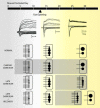Wiring and rewiring of the retinogeniculate synapse
- PMID: 21558027
- PMCID: PMC3099477
- DOI: 10.1016/j.conb.2011.02.007
Wiring and rewiring of the retinogeniculate synapse
Abstract
The formation and refinement of synaptic circuits are areas of research that have fascinated neurobiologists for decades. A recurrent theme seen at many CNS synapses is that neuronal connections are at first imprecise, but refine and can be rearranged with time or with experience. Today, with the advent of new technologies to map and monitor neuronal circuits, it is worthwhile to revisit a powerful experimental model for examining the development and plasticity of synaptic circuits--the retinogeniculate synapse.
Copyright © 2011 Elsevier Ltd. All rights reserved.
Figures




Similar articles
-
[Maturation and plasticity of visual system: neurogenesis, synaptogenesis, and myelogenesis. Report I. Retina and retinogeniculate projections].Vestn Oftalmol. 2012 May-Jun;128(3):37-41. Vestn Oftalmol. 2012. PMID: 23120924 Review. Russian.
-
Refinement of the retinogeniculate synapse by bouton clustering.Neuron. 2014 Oct 22;84(2):332-9. doi: 10.1016/j.neuron.2014.08.059. Epub 2014 Oct 2. Neuron. 2014. PMID: 25284005 Free PMC article.
-
Developmental remodeling of the retinogeniculate synapse.Neuron. 2000 Dec;28(3):955-66. doi: 10.1016/s0896-6273(00)00166-5. Neuron. 2000. PMID: 11163279
-
An evolving view of retinogeniculate transmission.Vis Neurosci. 2017 Jan;34:E013. doi: 10.1017/S0952523817000104. Vis Neurosci. 2017. PMID: 28965513 Free PMC article. Review.
-
Distinct roles for spontaneous and visual activity in remodeling of the retinogeniculate synapse.Neuron. 2006 Oct 19;52(2):281-91. doi: 10.1016/j.neuron.2006.07.007. Neuron. 2006. PMID: 17046691
Cited by
-
Ocular Dominance Plasticity in Binocular Primary Visual Cortex Does Not Require C1q.J Neurosci. 2020 Jan 22;40(4):769-783. doi: 10.1523/JNEUROSCI.1011-19.2019. Epub 2019 Dec 4. J Neurosci. 2020. PMID: 31801811 Free PMC article.
-
Development, form, and function of the mouse visual thalamus.J Neurophysiol. 2018 Jul 1;120(1):211-225. doi: 10.1152/jn.00651.2017. Epub 2018 Apr 11. J Neurophysiol. 2018. PMID: 29641300 Free PMC article. Review.
-
Refinement of Spatial Receptive Fields in the Developing Mouse Lateral Geniculate Nucleus Is Coordinated with Excitatory and Inhibitory Remodeling.J Neurosci. 2018 May 9;38(19):4531-4542. doi: 10.1523/JNEUROSCI.2857-17.2018. Epub 2018 Apr 16. J Neurosci. 2018. PMID: 29661964 Free PMC article.
-
Activity-induced MeCP2 phosphorylation regulates retinogeniculate synapse refinement.Proc Natl Acad Sci U S A. 2023 Oct 31;120(44):e2310344120. doi: 10.1073/pnas.2310344120. Epub 2023 Oct 23. Proc Natl Acad Sci U S A. 2023. PMID: 37871205 Free PMC article.
-
Developmental Remodeling of Thalamic Interneurons Requires Retinal Signaling.J Neurosci. 2019 May 15;39(20):3856-3866. doi: 10.1523/JNEUROSCI.2224-18.2019. Epub 2019 Mar 6. J Neurosci. 2019. PMID: 30842249 Free PMC article.
References
-
- Kano M, Hashimoto K. Synapse elimination in the central nervous system. Curr Opin Neurobiol. 2009;19:154–161. - PubMed
Publication types
MeSH terms
Grants and funding
LinkOut - more resources
Full Text Sources

